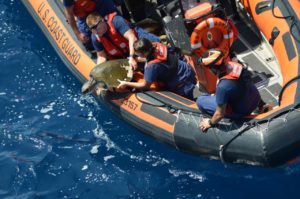 Terry Kerby says that he has been observing the marine life for the last 40 years. He mentions that this involves deep-sea submarines. He further notes that nothing made him realize that everything was changing like a phenomenon he experienced in the middle of the Pacific Ocean. In an area where life would be evident on a normal day, it had transformed into a biological desert. The fish and crabs that are always present were missing. He further said that the usual sponges and coral forest had disappeared. He is working with another biologist known as Brendan Roark who works at Texas A&M University. Their aim is to compare the seamounts that have been overfished. They will also be studying the protected areas. For instance, this month involved a study of four areas in the Pacific that include Hancock. For starters, this is an area that is located in the Papahanaumokuakea Marine National Monument. This is a park that is located in the Northern Hawaiian Islands. While the two gentlemen and their research teams knew that the area had been fished by coral harvesters and trawlers, they didn’t know the extent of the fishing. They also discovered that a huge amount of fishing gear had been left in the area. Even the black corals that are usually found at the bottom of the sea had been affected. These are regarded as the oldest forms of life on earth as they can live for up to 4,000 years.
Terry Kerby says that he has been observing the marine life for the last 40 years. He mentions that this involves deep-sea submarines. He further notes that nothing made him realize that everything was changing like a phenomenon he experienced in the middle of the Pacific Ocean. In an area where life would be evident on a normal day, it had transformed into a biological desert. The fish and crabs that are always present were missing. He further said that the usual sponges and coral forest had disappeared. He is working with another biologist known as Brendan Roark who works at Texas A&M University. Their aim is to compare the seamounts that have been overfished. They will also be studying the protected areas. For instance, this month involved a study of four areas in the Pacific that include Hancock. For starters, this is an area that is located in the Papahanaumokuakea Marine National Monument. This is a park that is located in the Northern Hawaiian Islands. While the two gentlemen and their research teams knew that the area had been fished by coral harvesters and trawlers, they didn’t know the extent of the fishing. They also discovered that a huge amount of fishing gear had been left in the area. Even the black corals that are usually found at the bottom of the sea had been affected. These are regarded as the oldest forms of life on earth as they can live for up to 4,000 years.
Dr. Roark said that it was a huge mistake allowing fishing in these restricted areas. This is an idea that a number of ecologists agree on. This comes at a time when the current Trump administration is thinking about removing the protections that have been offered to the nearly 10 national monuments under the jurisdiction of the United States government. Some of these monuments include Rose Atoll National Marine Monument and the Pacific Remote Islands National Marine Monument. In most cases, these monuments don’t allow fishing to take place in some designated areas. This involves 50 to 200 miles from the shoreline. The recommendation to cease protecting these areas was made by Interior Secretary Ryan Zinke. The memo explaining the reasons to cease the protection was even obtained by the Washington Post. However, a number of ecologists disagree with this idea. They argue that this is the only area where you can find untouched and rich ecosystems.








